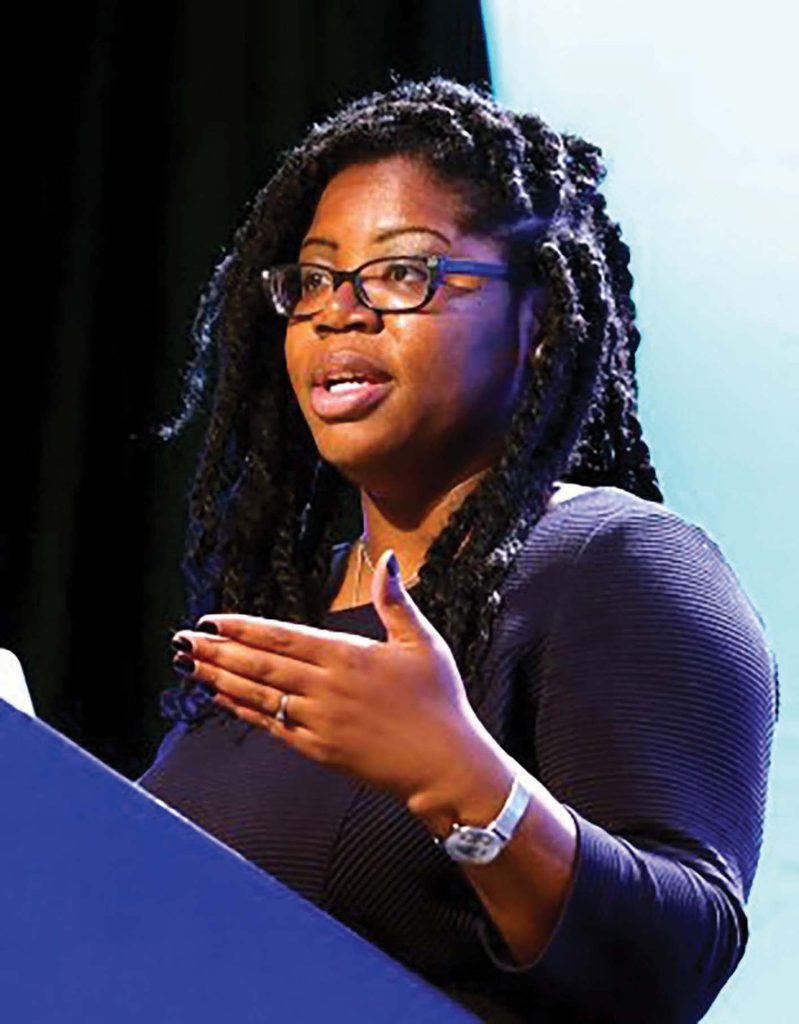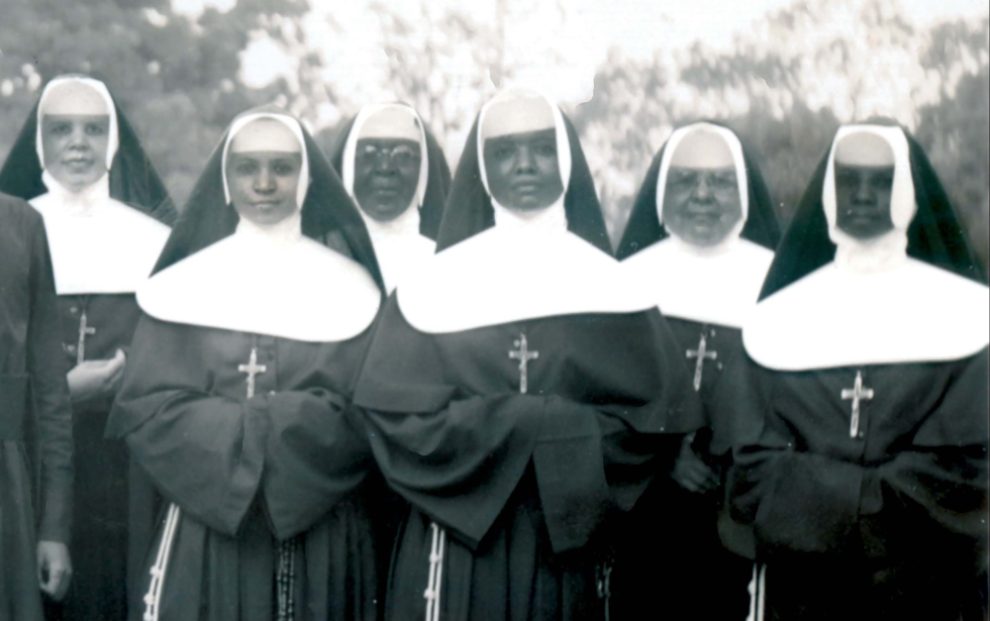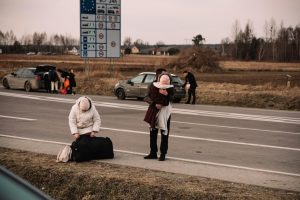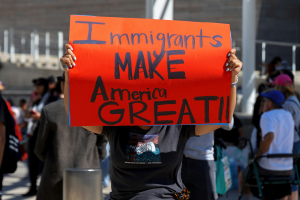Historian Shannen Dee Williams had never seen a Black nun until she stumbled across a 1968 news story about the founding of the National Black Sisters’ Conference. Williams writes in the preface of her new book, Subversive Habits (Duke University Press) that the realization that she wasn’t alone in this—that in fact very few U.S. Catholics, even Black Catholics, were aware of the existence of Black sisters—inspired her to embark on a decades-long research project to “understand the roots of the invisibility of Black Catholic sisters in our lives.”

Subversive Habits, the result of over 13 years of archival research and interviews with the Black Catholic community, provides the first full history of Black Catholic nuns in the United States ever written. The book spans the time from 1819, with the first documented examples of women of color who sought to enter religious life, to 2018, the 50th anniversary of the National Black Sisters’ Conference.
The legacy of these Black sisters who fought for inclusion over the past 200 years is a reminder “that racism and sexism have no place within the Catholic Church,” Williams says. “We’re not going to get anywhere until we understand . . . that white supremacy threatens us all, not just people of color.”
Far more than a history book, Subversive Habits is a call to honor the ongoing struggles of Black Catholic women in the face of white supremacy and racism within the Catholic Church. It shines a powerful spotlight on stories that have far too often been allowed to remain untold and forgotten. And it provides an important stepping stone toward proclaiming as a church that Black lives matter.
This book has been in process for a long time. Has the scope changed over the years that you’ve been doing your research?
When I began the project, I thought I would write about Black nuns and Black power. Then I interviewed Dr. Patricia Grey, formerly Sister of Mercy M. Martín de Porres, who was the chief architect of the National Black Sisters’ Conference, which was founded in 1968. In my conversations with her, as well as in some of the initial interviews I conducted, I realized that the project had to tell a more comprehensive story.
Grey was very adamant that I write a book not just about her or the National Black Sisters’ Conference or Black sisters and Black power. She was very adamant that I write a full history of Black sisters in the United States.
She said something to me that really stood out: “We were not the first sisters to revolt in the church. If you can, try to tell all our stories.” She was very invested in me turning my attention to the history of the nation’s Black sisterhoods. She told me, “Our foremothers in the church went through struggles that we have yet to really understand.” She was adamant that you couldn’t understand the formation of the National Black Sisters’ Conference without first understanding the labors of those pioneering generations of Black sisters.
After talking to her, almost instinctively I knew that I would write the first full history of Black Catholic sisters in the United States. It has taken me nearly 14 years to be able to do that.
Once I began doing interviews and digging into the archives of the Oblate Sisters of Providence and the Sisters of the Holy Family, I encountered this forgotten chapter in the history of the Black freedom struggle. Many archival sources and Black sisters’ dissertations document their respective orders’ histories and desegregation triumphs, but most often these feats were not written about anywhere else. Many Black sisters were also modest about their accomplishments.
When I asked the sisters why nothing was written down, they would tell me, “Well, we know what we did. It’s not necessary for us to toot our own horns.”
Even though very small circles of Black Catholics knew what these women had done, it was not something that had been incorporated into our dominant narratives of the American Catholic experience. And it was very important for me to make sure that was done. So Subversive Habits begins in 1819, with the first documented women of color who sought to enter religious life. It ends with the 50th anniversary of the National Black Sisters’ Conference in 2018.
How far back can you trace the history of Black women religious in the United States?
The earliest documentation we have of Black women wanting to go into religious life is 1819. But if you look at that earliest generation, many of them have roots in the earliest days of the church. Many of them can trace their lineage to free and enslaved people in Maryland, Florida, Louisiana, Kentucky, and Missouri—these cradles of American Catholicism.
What became clear to me very quickly was that when we talk about American Catholicism, we have to remember that there are two trans-Atlantic stories of American Catholicism. One begins in Europe, and the other begins with Africans and African-descended people living in Europe and Africa.
For me it was an epiphany to think about what it means that Catholicism was the first Black articulation of Christianity in what becomes the United States. So much of early African American history takes place within Catholic boundaries. The first recorded Christian marriage on land that became the United States is between a free Black Catholic woman from Spain and a Spanish soldier.
Although we do not have Black sisters until the early 19th century, they were among the earliest Catholic sisters to minister in the early church. They led Black sisterhoods and at least two white sisterhoods. So many of them were the descendants of some of the earliest Catholics in our nation.
Black Catholics have never been anomalies in our church. They are not footnotes in the story of American Catholicism. When we tell Black sisters’ stories, we are able to see the richness and the diversity of the American Catholic experience from the very beginning and the importance of Black women’s faithfulness and spiritual leadership even when they were not allowed to go into religious life.
What significant things do people tend to get wrong about the story of race and Catholicism in the United States?
I think the most dominant misconception is that Catholics were innocent bystanders in the history of white supremacy. We have to reckon with the fact that the church introduced African slavery in the Americas. The U.S. roots of this story do not begin in 1619 in Virginia, but nearly 60 years earlier in Spanish Catholic Florida. Segregation and exclusion were also Catholic traditions.
Not only did men and women’s religious orders have anti-Black admission policies, and not only did many of our nation’s earliest parishes practice segregation, but many Catholics, religious and lay, were among the nation’s first and largest slaveholders.
So, for me, the biggest myth is that the Catholic Church reluctantly embraced the practices and policies of white supremacy in our nation as opposed to being spiritual propagators of white supremacy and practicing it generally without apology.
You point out that some of our nation’s earliest saints were slaveholders or people who relied on enslaved people. Can you give an example?
Certainly. Elizabeth Ann Seton, the first saint from the United States, and St. Rose Phillipine Duchesne, the U.S. founder of the Society of the Sacred Heart, exploited slave labor in their ministries. Most early white orders, as well as the historically Creole Sisters of the Holy Family, were slaveholding communities. The vast majority of the earliest sisterhoods to minister in the United States prior to 1850 were either slaveholding communities or communities that utilized enslaved labor to establish the foundations of their institutions.
The one exception I always point out is the Oblate Sisters of Providence, founded by Servant of God Mother Mary Lange, who is one of six African Americans currently on the road to canonization. The community began in Baltimore in 1829 and was not a slave-holding community. They could have been, and that matters. They made a very conscious decision not to be. In fact, prior to the Civil War, they admitted at least eight women who were born into slavery. And at least one woman who was still enslaved came into the community and gained her freedom before she professed her vows.
Their story is the essential counterpoint to anyone who dares to attempt to justify or excuse other communities’ histories of slaveholding and segregation as a product of the times. Mother Lange and the early Oblate Sisters of Providence were also people of those times, and they did not enslave people.
Nor did the Oblate Sisters of Providence exhibit any idea of class: They didn’t have different statuses of sisters within their communities. Other communities established a sort of choir rank: There were sisters who taught and then those of lesser ranks who were relegated to domestic labor, sometimes called lay sisters. The Oblates did not have those distinctions within their communities. So they were very egalitarian for their time. Again, they were the exception not the rule in early communities of women religious.
Could you give a couple examples of ways in which the white institutional church actively worked against the inclusion of Black people?
There was the exclusion of Black people from many white-led Catholic religious institutions, educational institutions, and hospitals. But beyond the formal policies barring people of color, there were practices of segregation in parishes that forced people to the back of communion lines, as well as the church’s support of slavery.
Antislavery was not a dominant sentiment within the Catholic Church, certainly not within European and white American communities. The seeds of antislavery were sown within the Black Catholic community in the United States and in the larger Atlantic world.
I must stress this: The history of white supremacy in the Catholic Church is surprising only to white Catholics. If you ask most Catholics of color, they will tell you that their lived experiences of Catholicism document the centrality of white supremacy and exclusion in our church. So we also have to ask ourselves that very difficult question: Why is it that Catholic white supremacy is so invisible to so many other people?
I think one answer is found in the way white charity and mercy have been centered in Catholic narratives. As a church, we’ve never had to grapple with the fact that many white Catholics’ practice of charity has been contingent upon race.
Why is it controversial to state that someone is not charitable if their acts of charity are dependent upon the color of the recipient’s skin? We have these wonderful stories of sisters doing all of this noble work, but what does it mean if those sisters were slaveholders? What does it mean if those ministries don’t extend to certain people based on the color of their skin? These are the kinds of questions that far too many people have not been willing to ask or answer.
For example, there are so many stories of people who could not receive treatment at a Catholic hospital because they were Black. Those are the kinds of examples that inundate the historical record and yet have not been thoughtfully, meaningfully, and honestly incorporated into our understanding of American Catholicism.
Despite active attempts to exclude or segregate them, religious life also allowed Black women to resist white supremacy. How so?
For Black women, embracing the religious state constituted a radical act against white supremacy, slavery, and the sexual terrorism built into the institutions of slavery and segregation. One of the core arguments of my book is that to embrace the celibate religious state as a Black woman was to strike at the heart of one of the core tenets of white supremacy: the idea that Black people were inherently immoral and sexually deviant.
There were all sorts of comments about the immorality of Black people and that interracial sexual intimacy was about Black women seducing these otherwise moral white men. So much of the discourse centered on denying Black female virtue was, at its core, misogynoir and a justification for the crimes against humanity that were slavery and the slave trade.
In the 19th century, white priests and bishops denigrated Black sexuality and Black humanity, not simply through practicing slavery and segregation but also in their writing. For example, some suggested that the formation of the Oblate Sisters of Providence was a “profanation of the habit.”
This language was ubiquitous. So we have to think about what it means for Black women to embrace religious life in the institution that is most responsible for the rise of African slavery in the Americas. What does it mean for them to take the church at its word when it says that all people are equal under the eyes of God?
For them to do that, that’s a powerful and radical act. And we understand how radical it is because we see how violent the resistance becomes.
The early Sisters of the Holy Family’s embrace of the religious state was also an attack on the institution of slavery. Their third foundress, who did not own slaves, was Mother Josephine Charles. Her older sister attempted to groom her to participate in plaçage, this system of concubinage in which European and Creole men would take women of Indigenous and African descent as basically common-law wives.
When Mother Josephine Charles becomes a superior of the community, she begins to buy up properties in New Orleans that were associated with slavery and the sexual abuse of Black women and girls. The first property that she buys, with money inherited from her German father, is a former slave traders’ pen; the order turns it into a school. Then she eventually buys the famous quadroon ballroom where these plaçage transactions would be arranged, and she turns that into the Sisters of the Holy Family motherhouse and the headquarters for St. Mary’s Academy, which is the oldest secondary school for Black people in Louisiana.
We have very clear examples of how these women understood their calls to religious life not only as spiritual calls, but blows against the various dimensions of white supremacy that relegated Black people, specifically Black women and girls, to the lowest status in society.
If you had to summarize your book, what would you say is the legacy of Black Catholic sisters?
The legacy of Black Catholic sisters in the United States is best articulated in a statement given by Sister Loretta Theresa Richards, I think in 2009: “The Catholic Church wouldn’t be Catholic without us.” Subversive Habits tells the story of America’s real Sister Act, the story of how generations of Black Catholic women and girls called to religious life fought against racism, sexism, and exclusion to become consecrated women of God.
These are women who fought to make their church truly Catholic and their nation truly democratic. Without their efforts, without their suffering, and without their tenacious faithfulness, the struggle that we are fighting now against white supremacy would be so much more difficult within the Catholic Church.
I promise you: In many cases, when the church was forced to make changes for good and dismantle racial segregation and exclusion, there’s a Black sister in the story. Either she herself or one of her students or someone who has been touched by the legacy and ministries of Black sisters. That can also be said for the nation at large.
So that’s their legacy. Theirs is a legacy that reminds us that racism and sexism have no place within the Catholic Church.
What work would you like the church to do to grapple with its legacy of enslavement and racism?
Researchers have to be given full and complete access to archives. And that’s not just in regard to slavery and racism, but also with regard to colonialism, especially as this nation prepares to investigate Native American residential schools.
We also need to initiate a massive oral history project because of the realities of archival erasure and lack of access. We need the stories that have been passed on. We need the stories of people who have been engaged in so much of this antiracist work and who are still engaged in this antiracist work at every level. We need digital history projects on U.S. Black Catholicism, especially identifying where the nation’s Black parishes and schools have been and explaining why they closed.
I would also love to see individual dioceses and archdioceses as well as the pope formally apologize not only for colonialism in Africa and Asia and the doctrine of Discovery but also for slavery, segregation, and other sins of white supremacy. That has to be the essential first step. If you cannot even say it, we don’t get anywhere. We like to talk about reconciliation and peace, but those things are not possible without reckoning with the truth, teaching the truth, and actually beginning the work of justice and reparation. The church also needs to make reparations: There are plenty of examples of what that can look like both financially and spiritually, but there has to be a transformative plan.
We must understand that this history is with us forever. What would it mean if Catholics, in addition to making pilgrimages to Vatican City, also make pilgrimages to Elmina Castle, which is the site of the first Roman Catholic chapel in Sub-Saharan Africa? It is the launching place of the trans-Atlantic slave trade and represents this horrific human history that made possible the church’s expansion and the expansion of wealth in the modern Roman Catholic Church. All this comes through the exploitation and suffering of Indigenous and African-descended people. We have to recognize and own that the story of Elmina is just as important as the story of the Vatican.
We have to recognize that no one is an innocent bystander. This is not just simply a history for the descendants of enslaved people to carry: We all as Catholics have to carry it. It is our own history. I think we have a shot if we can at least get the formal apologies, get a clear understanding that Black people are not some anomalies within the church and that Black Catholicism has a long and rich history in the global church. If we can have the open and honest conversations about reparations and actually enact them, then we have a shot at actually making this church truly catholic and surviving the growing threat of white supremacy.
But we’re not going to get anywhere until we understand as citizens of this country, citizens of this world, and members of the Roman Catholic Church that white supremacy threatens us all, not just people of color.
We have to understand that white supremacy has no place within our church: It is antithetical to Catholicism. I think that’s the first step. And I think historical truth telling, teaching the “true truth” about our church—what Servant of God Sister Thea Bowman told us to do—is where we get started.
Do you think we’re getting closer to doing the work of making reparations?
Are we getting closer? I would say a church that often characterizes the rally cry of Black Lives Matter as antithetical to Catholicism is a church not yet prepared to deal seriously with its history and act on the righteous claims for racial reparation. If we cannot yet as a church loudly, proudly, and boldly say with both our words and our actions that Black lives matter, I’m not sure where we go from here.
If all lives matter, then Black lives matter. I’ll quote the National Black Sisters’ Conference in their recent statement in response to the Buffalo, New York, massacre: “If we do not act now, we will surely witness the demise and perhaps even the destruction of our nation.” That is how serious I think the threats of white supremacy and white nationalism are in our nation, in our church, and in our world.
I do believe that there are significant segments of our Catholic community that recognize the truth of the statement of the National Black Sisters’ Conference and who will proudly and unashamedly say that Black lives matter and that white supremacy has no place within our church. It’s not enough though.
This article also appears in the August 2022 issue of U.S. Catholic (Vol. 87, No. 8, pages 10-15). Click here to subscribe to the magazine.
Image: Sisters of the Holy Family, Christ the King Mission, Grand Coteau (Bellevue), Louisiana, 1941. Courtesy of the Department of Special Collections and University Archives, Marquette University Libraries.














Add comment